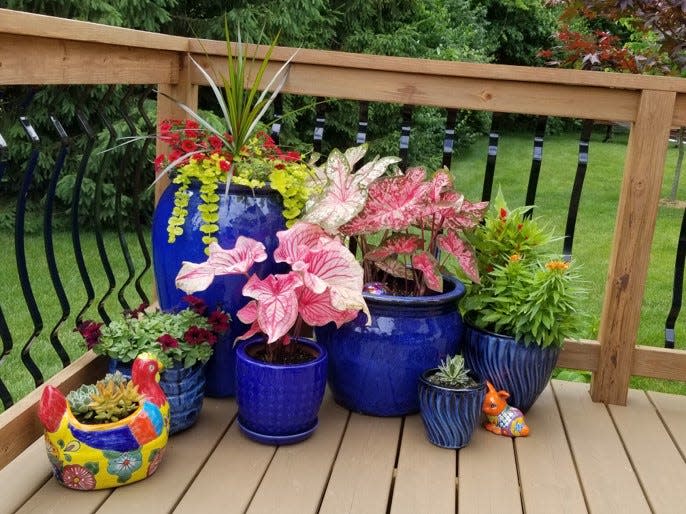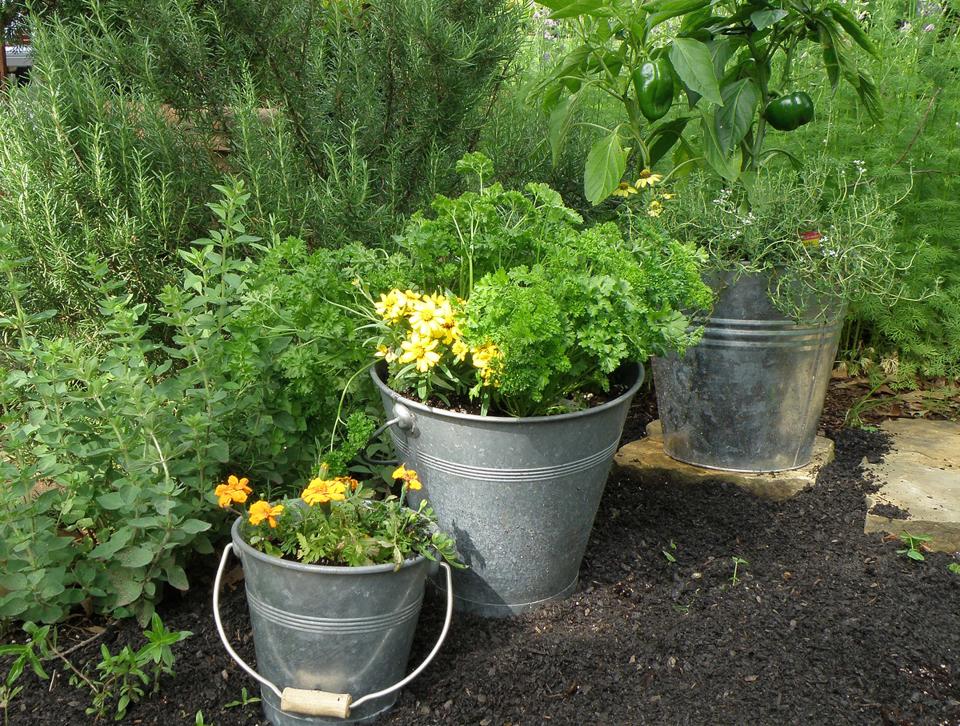Limited to a small space? Here's how to grow a successful container garden

Many gardeners may not have the space or desire to cultivate an extensive in-ground garden where they can grow their favorite flowers or vegetables. Residents of condominiums, apartments and retirement facilities may only have a small patio, balcony or porch where they can exercise their green thumb, but by gardening in containers, they can still have a productive and enjoyable garden. Containers can even be incorporated into existing in-ground growing spaces in the landscape including shrub beds, perennial gardens and woodland or shade gardens.
How-to: Now is the time to weed out poison ivy in your landscape. Here's how
Choosing containers
There is simply no limit to the variety of different containers on the market that can be used to grow plants outdoors. Garden centers, pottery shops and department stores will all have containers available in a wide range of styles and materials. Budget-conscious gardeners may even find the perfect unique container sitting unused in a basement, attic or garage. When choosing a container, consider how its color, design and material will match the style and décor of the house, garden or other outdoor space in which the container will be located.
Pots made of plastic, metal, glass and glazed pottery are non-porous and hold moisture longer, but may not be as natural in appearance as pots made of organic materials. Clay or terra cotta pots are porous and will lose moisture quickly in hot, dry weather conditions. Wooden window boxes, planters and baskets are often lined with plastic to protect the wood and thereby become non-porous.
No matter what type of container you chose, be sure that it has drainage holes in the bottom of the container. Any container will need to drain in order to ensure root health and to prevent the container from overflows during periods of heavy rainfall.
Some containers are frost-resistant and can be left outdoors during the winter months without becoming damaged. Many glazed ceramic and clay pots will crack and flake after freezing temperatures, and must be emptied and stored indoors for winter.
Only use soilless mixes
Because containers provide a limited space for roots to thrive, a soilless potting mix should be used when planting in any size container. Native soil from the yard or garden, or bagged soils should never be used in containers as these soils are too heavy and will not contain enough pore space for drainage, air movement and development of healthy root systems.
Soilless container mixes are readily available at any store which sells gardening supplies. These mixes contain lightweight materials such as perlite, vermiculite, peat and other organic materials. Some container mixes also contain a slow release fertilizer to supply nutrients to the plants.
How-to: Attract bees, butterflies with a pollinator garden
Thrillers, fillers and spillers
When choosing flowering and ornamental plants for containers, keep the size of the plants in proportion to the size of the container, and also keep the container size in proportion to the location in which it will be placed. When planting flowering plants in containers, I like to include thrillers, fillers and spillers. Thrillers are plants with an upright, vertical growth pattern such as elephant ears, canas, cocks comb, dracaena, and geraniums. Fillers are those smaller plants which tend to weave, spread and fill in open spaces in the container. Popular fillers include petunia, morning glory, coleus, ageratum and others. Spillers are plants with a vining or weeping growth pattern such as creeping Jenny, sweet potato vine or ivy. As these plants grow, they spill over the edge of the container.
For visual interest, consider incorporating green houseplants such as spider plant or ferns, tropical plants or succulents with their variety of colors, shapes and textures. These plants add contrast and visual interest when combined in a container of flowering annuals.

Vegetables and herbs in containers
Certain vegetables can also be grown in containers and yield the same amount as plants grown in the ground. For maximum success, choose compact varieties bred specifically for small spaces. These varieties generally have a reduced growth habit and will not grow too large for a container. Many of these varieties will have the term “bush” or “patio” in the name of the variety. Planting vegetable transplants directly into containers, as opposed to planting seeds into the same container, will yield a quicker harvest.
Warm season vegetables that can be grown in containers include tomato, eggplant, pepper, cucumber, beans, squash and others. There are even compact varieties of “baby” watermelon and cantaloupe that can be grown in a container. Compact varieties of cool season vegetables such as cabbage, carrot, radish, greens and beets can also be grown successfully in containers.
Containers are the perfect place to grow many culinary herbs, especially those that tend to spread profusely as many mint species tend to do. Locate containers with herbs close to the kitchen door or on a windowsill so that they are within arm’s reach when preparing dinner.
Seasonal containers
One of the benefits of gardening in containers is that you can change the plants in the containers as the seasons change. Containers on your front porch can provide late winter color in March and April with pansies before it's time to plant summer annuals in May. The same containers might provide fall color when planted with mums, flowering kale or asters. Some gardeners use containers year-round by placing evergreen boughs, holly branches or red-twig branches in containers for the winter.
Mike Hogan is Extension Educator, Agriculture and Natural resources, and associate professor with Ohio State University Extension. hogan.1@osu.edu
This article originally appeared on The Columbus Dispatch: How to grow a container garden on your porch, patio or balcony

